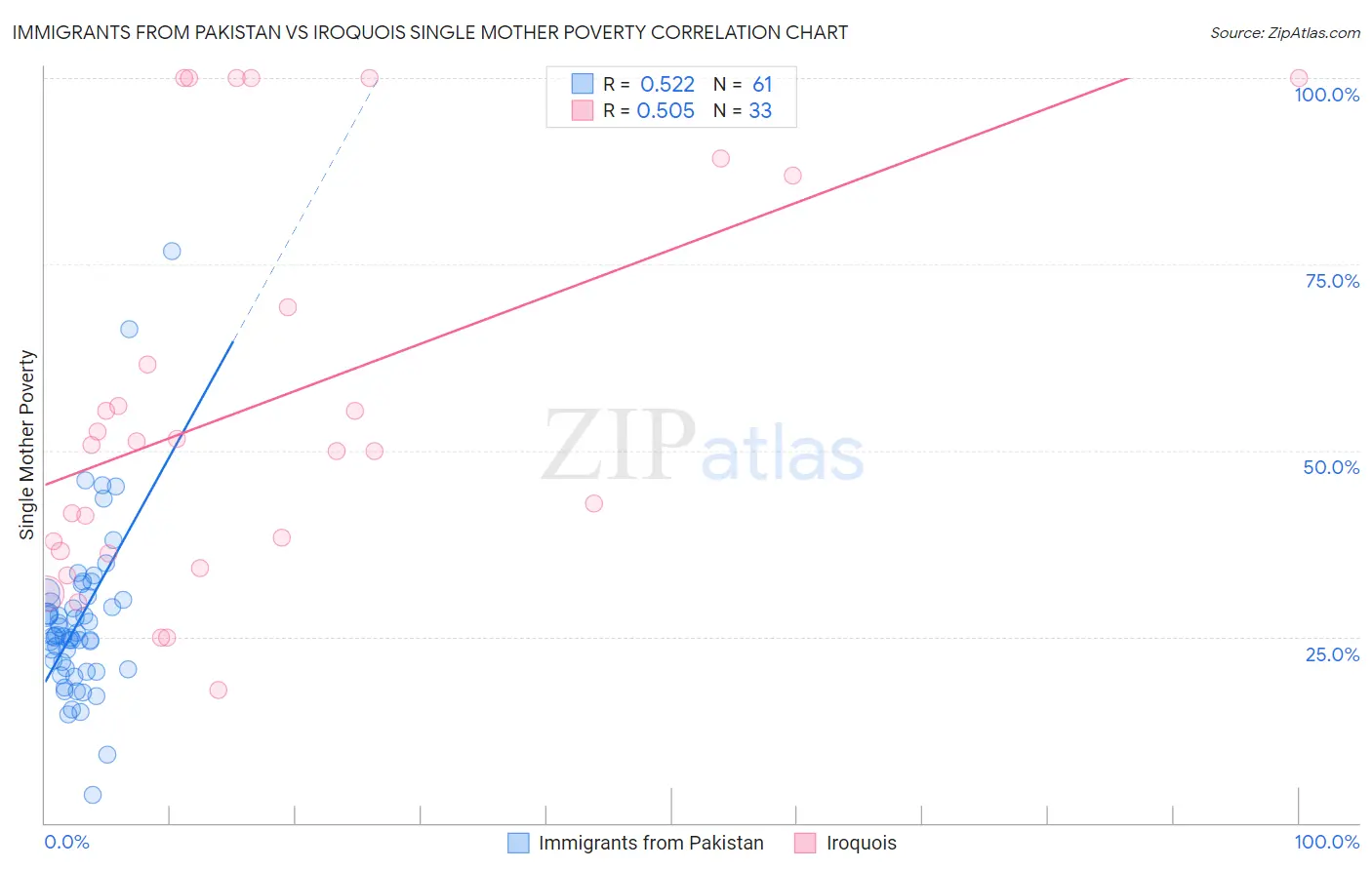Immigrants from Pakistan vs Iroquois Single Mother Poverty
COMPARE
Immigrants from Pakistan
Iroquois
Single Mother Poverty
Single Mother Poverty Comparison
Immigrants from Pakistan
Iroquois
26.0%
SINGLE MOTHER POVERTY
100.0/ 100
METRIC RATING
18th/ 347
METRIC RANK
34.8%
SINGLE MOTHER POVERTY
0.0/ 100
METRIC RATING
320th/ 347
METRIC RANK
Immigrants from Pakistan vs Iroquois Single Mother Poverty Correlation Chart
The statistical analysis conducted on geographies consisting of 278,589,508 people shows a substantial positive correlation between the proportion of Immigrants from Pakistan and poverty level among single mothers in the United States with a correlation coefficient (R) of 0.522 and weighted average of 26.0%. Similarly, the statistical analysis conducted on geographies consisting of 204,844,819 people shows a substantial positive correlation between the proportion of Iroquois and poverty level among single mothers in the United States with a correlation coefficient (R) of 0.505 and weighted average of 34.8%, a difference of 33.8%.

Single Mother Poverty Correlation Summary
| Measurement | Immigrants from Pakistan | Iroquois |
| Minimum | 3.7% | 17.9% |
| Maximum | 76.8% | 100.0% |
| Range | 73.0% | 82.1% |
| Mean | 27.3% | 56.0% |
| Median | 25.0% | 50.8% |
| Interquartile 25% (IQ1) | 20.7% | 36.4% |
| Interquartile 75% (IQ3) | 30.2% | 78.1% |
| Interquartile Range (IQR) | 9.5% | 41.7% |
| Standard Deviation (Sample) | 11.5% | 26.1% |
| Standard Deviation (Population) | 11.4% | 25.7% |
Similar Demographics by Single Mother Poverty
Demographics Similar to Immigrants from Pakistan by Single Mother Poverty
In terms of single mother poverty, the demographic groups most similar to Immigrants from Pakistan are Immigrants from Eastern Asia (26.1%, a difference of 0.14%), Immigrants from China (26.1%, a difference of 0.27%), Asian (26.0%, a difference of 0.28%), Bolivian (25.9%, a difference of 0.46%), and Immigrants from Bolivia (26.2%, a difference of 0.46%).
| Demographics | Rating | Rank | Single Mother Poverty |
| Iranians | 100.0 /100 | #11 | Exceptional 25.5% |
| Bhutanese | 100.0 /100 | #12 | Exceptional 25.6% |
| Indians (Asian) | 100.0 /100 | #13 | Exceptional 25.8% |
| Immigrants | Singapore | 100.0 /100 | #14 | Exceptional 25.8% |
| Immigrants | Ireland | 100.0 /100 | #15 | Exceptional 25.8% |
| Bolivians | 100.0 /100 | #16 | Exceptional 25.9% |
| Asians | 100.0 /100 | #17 | Exceptional 26.0% |
| Immigrants | Pakistan | 100.0 /100 | #18 | Exceptional 26.0% |
| Immigrants | Eastern Asia | 100.0 /100 | #19 | Exceptional 26.1% |
| Immigrants | China | 100.0 /100 | #20 | Exceptional 26.1% |
| Immigrants | Bolivia | 100.0 /100 | #21 | Exceptional 26.2% |
| Immigrants | Korea | 100.0 /100 | #22 | Exceptional 26.2% |
| Burmese | 100.0 /100 | #23 | Exceptional 26.2% |
| Immigrants | Moldova | 100.0 /100 | #24 | Exceptional 26.2% |
| Immigrants | Asia | 100.0 /100 | #25 | Exceptional 26.3% |
Demographics Similar to Iroquois by Single Mother Poverty
In terms of single mother poverty, the demographic groups most similar to Iroquois are Chippewa (34.8%, a difference of 0.24%), Immigrants from Honduras (34.7%, a difference of 0.39%), Paiute (35.1%, a difference of 0.87%), Cherokee (34.5%, a difference of 0.91%), and Dominican (34.5%, a difference of 1.0%).
| Demographics | Rating | Rank | Single Mother Poverty |
| Immigrants | Dominican Republic | 0.0 /100 | #313 | Tragic 34.4% |
| Chickasaw | 0.0 /100 | #314 | Tragic 34.4% |
| Hopi | 0.0 /100 | #315 | Tragic 34.5% |
| Dominicans | 0.0 /100 | #316 | Tragic 34.5% |
| Cherokee | 0.0 /100 | #317 | Tragic 34.5% |
| Immigrants | Honduras | 0.0 /100 | #318 | Tragic 34.7% |
| Chippewa | 0.0 /100 | #319 | Tragic 34.8% |
| Iroquois | 0.0 /100 | #320 | Tragic 34.8% |
| Paiute | 0.0 /100 | #321 | Tragic 35.1% |
| Blacks/African Americans | 0.0 /100 | #322 | Tragic 35.2% |
| Kiowa | 0.0 /100 | #323 | Tragic 35.5% |
| Ottawa | 0.0 /100 | #324 | Tragic 35.5% |
| Ute | 0.0 /100 | #325 | Tragic 35.7% |
| Seminole | 0.0 /100 | #326 | Tragic 35.8% |
| Yakama | 0.0 /100 | #327 | Tragic 36.4% |